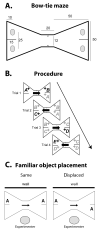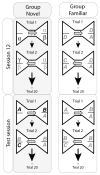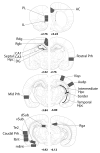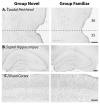Qualitatively different modes of perirhinal-hippocampal engagement when rats explore novel vs. familiar objects as revealed by c-Fos imaging
- PMID: 20092559
- PMCID: PMC4235254
- DOI: 10.1111/j.1460-9568.2009.07042.x
Qualitatively different modes of perirhinal-hippocampal engagement when rats explore novel vs. familiar objects as revealed by c-Fos imaging
Abstract
Expression of the immediate-early gene c-fos was used to test for different patterns of temporal lobe interactions when rats explore either novel or familiar objects. A new behavioural test of recognition memory was first devised to generate robust levels of novelty discrimination and to provide a matched control condition using familiar objects. Increased c-Fos activity was found in caudal but not rostral portions of the perirhinal cortex (areas 35/36) and in area Te2 in rats showing object recognition, i.e. preferential exploration of novel vs. familiar objects. The findings are presented at a higher anatomical resolution than previous studies of immediate-early gene expression and object novelty and, crucially, provide the first analyses when animals are actively discriminating the novel objects. Novel vs. familiar object comparisons also revealed altered c-Fos patterns in hippocampal subfields, with relative increases in CA3 and CA1 and decreases in the dentate gyrus. These hippocampal changes match those previously reported for the automatic coding of object-spatial associations. Additional analyses of the c-Fos data using structural equation modelling indicated the presence of pathways starting in the caudal perirhinal cortex that display a direction of effects from the entorhinal cortex to the CA1 field (temporo-ammonic) when presented with familiar objects, but switch to the engagement of the direct entorhinal cortex pathway to the dentate gyrus (perforant) with novel object discrimination. This entorhinal switch provides a potential route by which the rhinal cortex can moderate hippocampal processing, with a dynamic change from temporo-ammonic (familiar stimuli) to perforant pathway (novel stimuli) influences.
Figures







References
-
- Aggleton JP. One-trial object recognition by rats. Q J Exp Psychol. 1985;37B:279–294.
-
- Aggleton JP, Brown MW. Contrasting hippocampal and perirhinal cortex function using immediate early gene imaging. Q J Exp Psychol B. 2005;58:218–233. - PubMed
-
- Albasser MM, Davies M, Futter JE, Aggleton JP. Magnitude of the object recognition deficit associated with perirhinal cortex damage in rats: Effects of varying the lesion extent and the duration of the sample period. Behav Neurosci. 2009;123:115–124. - PubMed
-
- Albasser MM, Poirier GL, Warburton EC, Aggleton JP. Hippocampal lesions halve immediate-early gene protein counts in retrosplenial cortex: distal dysfunctions in a spatial memory system. Eur J Neurosci. 2007;26:1254–1266. - PubMed
-
- Bast T. Toward an integrative perspective on hippocampal function: from the rapid encoding of experience to adaptive behavior. Rev Neurosci. 2007;18:253–281. - PubMed
Publication types
MeSH terms
Substances
Grants and funding
LinkOut - more resources
Full Text Sources
Miscellaneous

